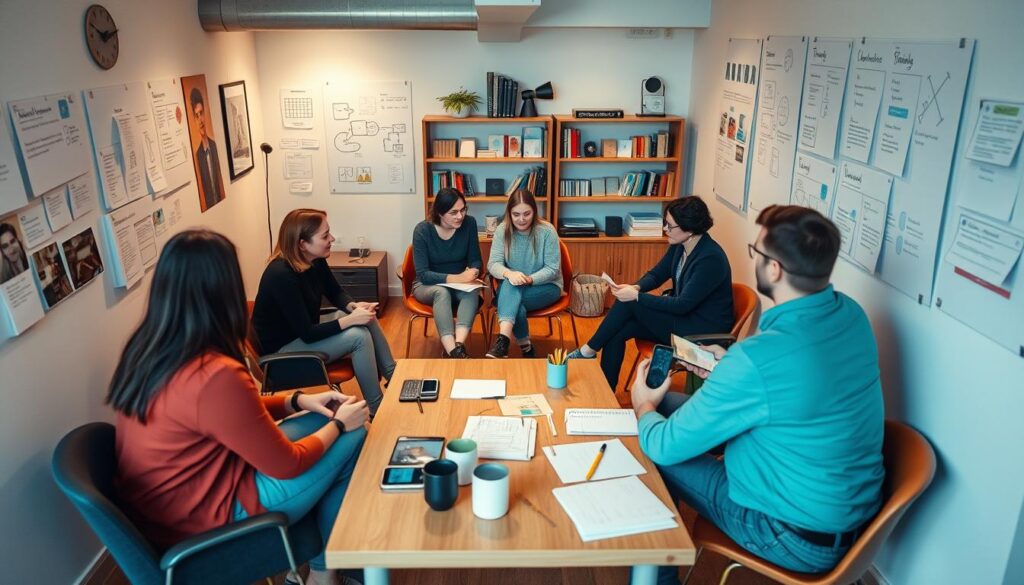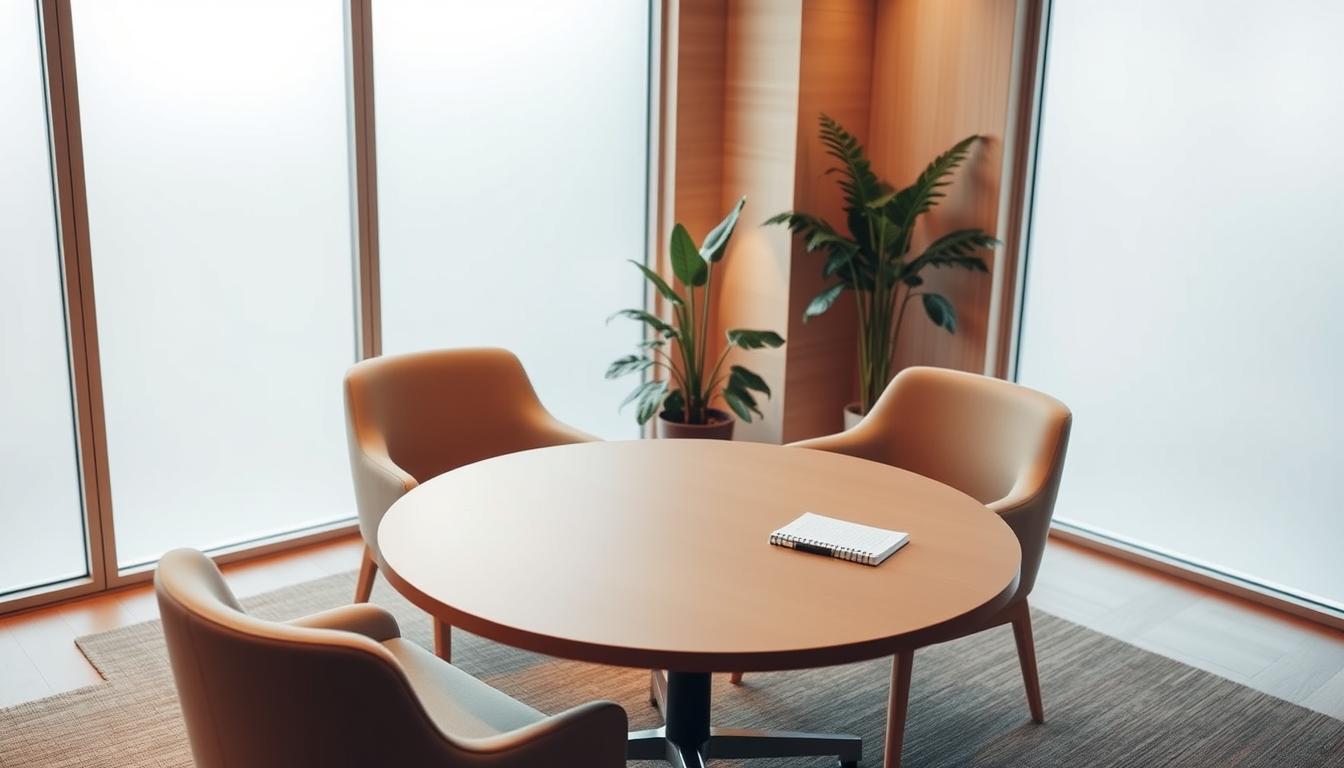“The key to good design is understanding the user.” – Steve Jobs, Co-founder of Apple Inc.
Steve Jobs said it best: the heart of great user experience (UX) is knowing your audience well. User interviews are a key tool for UX experts. They help uncover what users need and want, guiding design and development.
User interviews usually last 30 to 60 minutes with one person. They offer a flexible way to find new ideas and understand users better. These talks help UX pros learn about users’ thoughts, feelings, and experiences.
In this guide, we’ll cover the basics of user interviews. We’ll look at different types, best practices, and how to use them. By the end, you’ll know how to do user interviews that improve UX and design.
Key Takeaways
- User interviews are a powerful research method that provide deep insights into user attitudes, behaviors, and experiences.
- Interviews can be used throughout the product development cycle, from ideation to post-launch listening.
- Generative interviews are crucial for uncovering opportunities for innovation and driving user-centric design.
- Interviews generate qualitative data that can be used alongside quantitative methods for a comprehensive understanding of user needs.
- Effective user interview techniques, such as building rapport and using probing questions, are essential for extracting valuable insights.
What is a User Interview?
User interviews are a key tool in user experience (UX) design. They are conversations between an interviewer and a participant. The interviewer asks questions to learn about the participant’s thoughts and experiences.
The main goal is to understand users better, find out what they need, and get detailed feedback. This feedback helps shape the design process.
Definition and Purpose
A user interview is a way to gather qualitative data. The interviewer talks with participants to learn about their experiences and what they like or dislike. This helps designers and teams understand their users better.
The aim is to get rich, detailed information. This information is key to making informed decisions about the user experience.
Importance in UX Research
User interviews are vital in UX research. They offer insights that other methods like user research, usability testing, or customer journey mapping can’t provide. By talking directly with users, teams can find out what users really need.
They can also identify problems and understand the user’s point of view. This approach is essential for creating products that meet user needs and offer a smooth experience.
| Interview Type | Description |
|---|---|
| Structured | Follows a predetermined set of questions, offering a standardized approach to data gathering and participant comparison. |
| Unstructured | Adopts a more open-ended, conversational style, allowing for deeper exploration of user thoughts and experiences. |
| Semi-Structured | Combines predetermined questions with the flexibility to follow up and delve deeper into participant responses. |
By using user interviews, UX teams can get crucial insights. These insights help drive the design process and create products that users love. Understanding users is the first step to delivering great user experiences.
Types of User Interviews
Not all interviews are the same in user research. The type you pick can really change what you learn and how you use it. Let’s look at the three main types: structured, semi-structured, and unstructured.
Structured Interviews
Structured interviews use closed-ended questions. They’re good when you already know a lot about the user feedback and personas. This method is best for when your product is almost ready or has just come out. It helps get specific data to check your ideas and improve the user experience.
Semi-Structured Interviews
Semi-structured interviews mix open-ended and closed-ended questions. This lets you be more flexible and spontaneous. It’s perfect when you know the user personas well and have a prototype to show. The open-ended questions give deeper insights, while the structured parts keep the conversation focused.
Unstructured Interviews
Unstructured interviews are completely free-flowing, with questions asked as they come up. They’re best at the start of a project, when you’re just starting to learn about your users. They let you explore new areas and find surprises.
| Interview Type | Best Use Case | Key Characteristics |
|---|---|---|
| Structured | End of project, product launch | Closed-ended questions, researcher has good user understanding |
| Semi-Structured | Prototype testing, familiar with user personas | Mix of open-ended and closed-ended questions, flexible |
| Unstructured | Early-stage exploration, domain research | Completely spontaneous, questions based on previous responses |
Knowing the strengths and when to use each type helps user researchers get the best user feedback. They can design better personas and user experiences.
“Interviews can provide qualitative data about user thoughts, beliefs, motivations, and expectations, helping in understanding user experiences.”
Preparing for a User Interview
Conducting user interviews is key in user-centered design. Before starting, thorough preparation is vital. This includes setting clear goals, creating a recruitment plan, and making an interview guide.
Identifying Goals and Objectives
Start by defining your goals for the interviews. These should be specific and focus on understanding user behaviors or pain points. Aligning your research with your product ensures the insights are useful for your user persona and user-centered design.
Creating a Recruitment Plan
Choosing the right participants is essential. Develop a plan that outlines who to recruit based on demographics and product use. This ensures the insights reflect your ctrls.tech user base accurately.
Developing an Interview Guide
Creating a structured interview guide is crucial. Use open-ended questions to get users to share their experiences. Test the guide before the interviews to make any needed changes.
Spending time on preparation sets the stage for a successful research process. It helps inform your user-centered design and creates better solutions for your ctrls.tech users.
Conducting the User Interview
Starting your user research journey means diving into user interviews. These interviews are key to getting valuable insights. You need to make the interview space welcoming, ask the right questions, and use smart probing to get more from the user.
Setting the Scene
First, create a friendly setting for the interview, whether it’s face-to-face or online. Welcome the participant warmly and chat a bit to build rapport. This makes them feel at ease and more likely to share openly.
It’s all about starting a natural conversation, not a strict Q&A session.
Asking the Right Questions
Make a list of open-ended questions that let the user share their thoughts and experiences. Skip yes/no questions and go for ones that spark deeper conversations. This way, you can really understand their user experience and what they need.
Tactful Probing Techniques
As the interview goes on, use smart ways to dig deeper into what the user says. Listen actively and ask more questions to get them to share more. This helps you gather detailed, useful data for your usability testing and user research.
Remember, it’s not just about asking questions. It’s about making the user feel valued and heard. By getting good at this, you can uncover insights that improve your designs and user experiences.
Analyzing User Interview Data
Unlocking the value of user interviews requires careful analysis of the data. This involves transcribing interviews, finding key themes, and using qualitative tools. By deeply examining the insights, we can uncover a wealth of information. This drives user-centered design and improves the customer journey mapping.
Transcribing Interviews
The first step is to transcribe the interviews word for word. This ensures we don’t miss any user feedback. The transcripts are the base for deeper analysis, helping us spot emerging themes.
Identifying Key Themes
With the transcripts ready, we start finding key themes and patterns. We review the data closely, code responses, and group similar insights. This helps us understand user needs, pain points, and hopes.
Using Qualitative Analysis Tools
We use various qualitative tools to analyze the data. These tools help with sentiment analysis, text mining, and mapping user journeys. They make it easier to spot and understand themes, turning raw data into actionable user-centered design strategies.
| Quantitative Analysis | Qualitative Analysis |
|---|---|
| Focuses on numerical data, such as task completion rates, error frequencies, and user demographics. | Examines subjective, contextual data, including user attitudes, behaviors, and experiences. |
| Answers questions about user behavior, such as feature usage and unmet needs. | Provides insights into the “why” behind user actions and attitudes. |
| Employs statistical methods and data visualization techniques. | Utilizes thematic analysis, coding, and interpretive techniques. |
By combining quantitative and qualitative analysis, we gain a full understanding of the user experience. This helps us make informed decisions and design user-centered solutions.

“Analyzing user interview data is a critical step in the UX research process, as it allows us to uncover the true needs and pain points of our users. By thoroughly examining the qualitative insights, we can make more informed design decisions and create experiences that truly resonate with our audience.”
Best Practices for User Interviews
Effective user interviews are key to great user research and user experience (UX) design. At ctrls.tech, we focus on building rapport, ensuring comfort, and staying neutral. These are crucial for good user interviews.
Building Rapport with Participants
Getting along with your interviewees is vital for honest feedback. Show you’re listening with nods, eye contact, and phrases like “I see” or “Tell me more.” Speak at a comfortable pace to make them feel relaxed.
Ensuring a Comfortable Environment
A welcoming, quiet space is essential for user interviews. Whether it’s in-person or online, reduce distractions and keep the area tidy. Offer water and use a private spot. Give participants enough time to answer fully.
Maintaining Neutrality
It’s important to be friendly yet professional during interviews. Don’t interrupt or try to influence answers. Use phrases like “I understand” or “That’s helpful” to let them share freely.
By sticking to these tips, you create a space where participants can share valuable insights. This helps in making better user experience designs.
Common Challenges in User Interviews
User interviews are great for understanding what users need. But, they can also face unique challenges. To succeed, you must deal with nervous participants and manage those who talk too much.
Dealing with Nerves
Many people feel nervous at the start of an interview. Start with simple, open-ended questions. Speak slowly and clearly to help them relax.
Build a friendly rapport and reassure them. Give them time to get comfortable. This can lead to more honest and helpful answers.
Navigating Difficult Questions
Interviews can sometimes touch on sensitive topics. Be ready to handle tough questions without judgment. Stay neutral and empathetic.
If the conversation gets tough, gently steer it back on track. Use follow-up questions to get more insights, even when it’s hard.
Managing Dominant Personalities
Sometimes, one person might take over the interview. Use active listening and politely interrupt to keep the conversation balanced. Remind them of the interview’s goals.
Make sure everyone gets a chance to share their thoughts. This way, you can get a well-rounded view from all participants.
Dealing with the challenges of user interviews takes preparation and good people skills. With the right approach, UX professionals can gather valuable insights. These insights help shape designs that truly meet user needs.
Incorporating Insights into UX Design
User interviews are key in UX design, offering insights that shape digital experiences. Designers use this feedback to meet user needs and improve the product over time.
Translating User Feedback into Solutions
The quality of insights from user interviews greatly affects design choices. Designers must analyze the data to find patterns and pain points. This helps create features that solve problems and engage users.
Prioritizing User Needs
It’s crucial to focus on user needs in UX design. Designers use interview insights to create user personas. This helps make decisions that meet user needs, improving the user experience and satisfaction.
Iterative Design Based on Findings
Using user interview findings in an iterative design process is key. Designers validate changes and gather feedback to refine the product. This keeps the customer journey mapping in line with user expectations, leading to a better digital experience.
“Usability testing methods, such as session recording, heatmaps, and eye tracking, are invaluable for validating design decisions based on user interview insights.”
By using user interview insights in UX design, companies can create products that engage their audience. This user-focused approach is essential for digital transformation and long-term success.
Leveraging Technology in User Interviews
Technology has made user research a key part of UX design. It offers tools to make user interviews more efficient and effective. Video conferencing lets us conduct interviews remotely, reaching more people and offering flexibility.
Tools like Zoom, Microsoft Teams, and Google Meet make it easy to have face-to-face talks. They let researchers see users’ reactions and behaviors live.
Recording tools and software are also vital for capturing user insights. Programs like ctrls.tech and Descript help with recording, transcribing, and analyzing interviews. They make sure data is accurate and help researchers focus on the details of user feedback.
Using user research and usability testing tools gives researchers deeper insights. AI in these tools can summarize interviews, find key themes, and even detect emotions. This technology helps uncover valuable insights for better design.
“Technology has changed how we do user interviews, making remote research easy and efficient. Video conferencing and recording tools have greatly improved our ability to gather and analyze feedback. This leads to more informed design choices.”
As the UX field grows, using technology in user interviews will become even more important. By using these tools, researchers can understand users better, speed up design, and create products that really connect with people.
Case Studies of Successful User Interviews
Looking at successful user interviews can teach us a lot. Renowned UX designers share their experiences. They give tips on how to make interviews work well, improving products and making users happy.
Insights from Renowned UX Designers
UX researchers should have three case studies, says industry experts. One for generative research, another for evaluative, and maybe a third. Good case studies can open doors, as the author learned.
Choosing projects for case studies is key. Pick ones that show your user persona and what you’re passionate about. It shows your skills and how you design for users.
Lessons Learned from Real Projects
Case studies should dive deep into one project. They should show how the researcher thought and worked with others. It’s about the project’s impact, even if it’s not just numbers.
Case studies help show how you solve problems and make decisions. But, keep them focused on research. Don’t include designs unless you’re a designer too.
Continuous Improvement Through User Interviews
In the world of user-centric design, the goal is always to improve. By getting user feedback and changing with user needs, companies keep their products up to date. This cycle of user research and making things better is key to successful customer journey mapping.
There are many ways to do continuous interviews, like getting broad feedback or doing in-depth user talks. These regular chats help teams act fast, plan their product roadmap, and build a culture based on research.
Gathering Feedback Regularly
Continuous user interviews give teams quick and ongoing insights. Teresa Torres, a top user experience expert, says talking to customers weekly, even if it’s not perfect, helps a lot. It shows surprises and things you might not understand. It’s best to talk to a customer at least once a week to cut down the time between chats.
For teams without regular user talks, continuous interviews are crucial. Starting with a 30-minute weekly session with product users is a good idea. It helps keep the product in line with what users need.
Adapting to User Needs Over Time
Now, research is not just one-time but ongoing. It’s about getting constant feedback to keep improving. By making decisions based on real user insights, companies can lower risks and stay ahead.
To make this easier, there’s a guide for building opt-in forms to find users for interviews. The playbook for continuous interviews is flexible, letting you ask personalized questions. There’s also a note-taking template and an analysis template to organize feedback and find trends.
Creating a culture of continuous improvement through user interviews is vital for any company aiming for top-notch, user-focused experiences. By always getting feedback and changing with user needs, teams can keep their products and services leading in customer satisfaction.
Conclusion: The Power of User Interviews
User interviews are a key tool in UX research. They give deep insights into what users need and want. By focusing on users, companies can understand their audience better. This helps in making designs that truly connect with users.
Summing Up Key Takeaways
This guide showed how crucial user interviews are. They help us understand why users behave a certain way. They also reveal problems and check our assumptions.
These methods are vital for getting feedback and planning marketing. They help teams create products that really meet user needs.
Encouraging a User-Centric Approach
User interviews help teams think more about users. By talking to users often, teams get to know them better. This leads to creating solutions that solve real problems.
This focus on users improves the experience and boosts success in the market.



